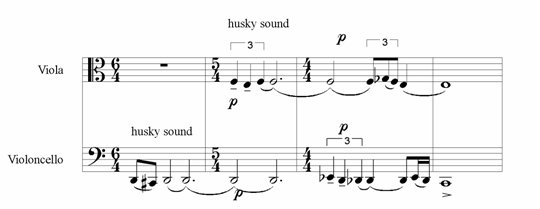
ARCHIVED CONTENT - REDIRECT
|
ELLEN TAAFFE ZWILICH
CONCERTO FOR HORN AND STRING ORCHESTRA
A MUSICAL ANALYSIS
By
Abstract ……………………………………………………………………vi
Chapter Page
1. INTRODUCTION AND PURPOSE …………………………………....1
2. ELLEN TAAFFE ZWILICH ……………………………………………6
3. MUSICAL ANALYSIS ………………………………………………..12
4. PERFORMANCE SUGGESTIONS …………………………………..38
BIBLIOGRAPHY ………………………………………………….............45
BIOGRAPHCAL SKETCH …………………………………………..........47
(All
musical examples are from the full score of Concerto
for Horn and String Orchestra
by Ellen Taaffe Zwilich, Merion Music, Inc.)
Example Page
1. measure 1-4, viola and violoncello ..…………………………..…………..14
2. measure 9, violoncello………………………………………….…………16
3.
measure 16-21,
horn……………………………………………………...17
(All horn examples are in F
horn)
4. measures 41-42, viola …………………………………………....………18
5. measures 50-51, horn, viola, violoncello, and contrabass..…………....……20
6. measures 73-76, horn ……………………………………………………21
7. measures 80-82, horn andviola …………………………………………...21
8. cadenza, measures 7-14, horn ……………………………………………24
9. cadenza, measures 20-22, horn …………………………………………..24
10.
measures 172-175, horn, violin I, II, viola, violoncello,
and
contrabass…………………………………………...……………….....27
11. measures 190-194, violin I, II, viola, and violoncello …....….……………29
12. measure 197, horn ……………………………………………………...30
13. measure 244-246, violin I, II, viola, violoncello, and contrabass …..…......31
14. measures 253-255, horn, violoncello, and contrabass …...……………...32
15. measures 275-276, horn, violoncello, and contrabass …………………..33
16.
measures
288-295,
horn, violin I, II, viola, violoncello, and
contrabass
……………………………………………………………...35
This treatise represents a musical analysis of the Concerto for Horn and String Orchestra by Ellen Taaffe Zwilich. The author corresponded with Dr. Zwilich and David Jolley, for whom this concerto was written. Their thoughts on the process of composing and performing this piece are included within the research by the author of the publications and analysis of the work. It is the intention of the author to give a theoretical and musical analysis of this piece as well as biographical information on Ellen Taaffe Zwilich. This information is intended to help any horn player in the performance of the Concerto.
The information assembled in this treatise is a compilation of several sources. The writer’s initial contact with the Concerto was through a performance of the piece on October 31, 1998, with the Florida State University Symphony Orchestra, Alexander Jiménez, conductor. Information about Ellen Taaffe Zwilich was found in The Concise Baker’s Biographical Dictionary of Musicians and in periodicals. Correspondence with Dr. Zwilich by telephone and in writing provided invaluable information on her thoughts about this concerto and its composition. Her agent, Music Associates of America, provided a press package with several articles about her and her works throughout her career. The writer corresponded with David Jolley, soloist and founding member of the Orpheus Chamber Orchestra, for whom this concerto was written and with whom it received its first performance. He offered his thoughts about the work and explained the process of bringing together all the parties involved in its commission. Jolley’s suggestions for performance, along with the writer’s own performance experience, provide the sources for performance suggestions. (See chapter four).
The Concerto for Horn and String Orchestra (1993) by Ellen Taaffe Zwilich was commissioned by the Bravo! Colorado Music Festival, Rochester Philharmonic Orchestra, Orpheus Chamber Orchestra and hornist David Jolley. Additional funding was provided through a grant from the Meet the Composer/Reader’s Digest Commissioning Program in partnership with the National Endowment for the Arts and the Lila Wallace-Reader’s Digest Fund.
David
Jolley
was instrumental in putting together the organizations
involved in this commission. Initially the Bravo! Colorado
Music Festival offered to help and this led to the collaboration with
the Rochester Philharmonic Orchestra. The work received its
first performance in Vail,
Zwilich’s language is forthright melodicism and mostly traditional harmony with rhythmically insistent writing. It is concise and emphatic, though in its general outline [it] follows the traditional concerto mold of fast-slow-fast pacing.
The horn writing is quite good. The mood is somber, more Britten than Bartók, though the rhythmic interest could be credited to the latter. [2]
Music
Critic Sharon McDaniel of the Democrat
and Chronicle,
The listener is swept up in this excursion not only by propulsive rhythmic vitality, but by soaring melodies, at once dramatic and simple. Every turn reveals a new element in the landscape: a change of character in the strings, a new color in the horn.
Zwilich is the master landscape artist, not only handling the living materials with deft assurance, but blending them into a unity. Her polished orchestral writing lends the richest possible growing environment to her melodic and rhythmic ideas. [3]
The
first performance in
David Jolley and his Orpheus colleagues also gave a polished account of Ellen Taaffe Zwilich’s Concerto for Horn and Strings, which was commissioned partly by the orchestra. Ms. Zwilich interestingly casts the horn against type, in a dark, introverted piece seemingly obsessed with the cramped interval of a semitone. The work is finely wrought in a style that evokes Shostakovich but by now must be considered Ms. Zwilich’s own.4
The involvement of the Orpheus Chamber Orchestra helped obtain the support of the Meet the Composer/Reader’s Digest Commissioning Program. Jolley chose Zwilich to compose this concerto after hearing her Double Quartet for Strings. He was “impressed by the inherent nobility of expression in Zwilich’s work.”5
Dr. Zwilich’s ability to capture the character of the horn, from warm and soulful to bold and brassy, contributes to making this concerto a staple of the repertoire from the last decade of the twentieth century. The author’s intention is to provide a musical analysis of this concerto, as well as biographical information about Ellen Taaffe Zwilich and some of her thoughts on the process of its composition. It is hoped this analysis, along with musical examples and information from the composer, will assist the horn player in preparing for performances of this concerto.
One of the drawbacks to performing twentieth-century music is the performer’s fear of unfamiliar music or style of music. At first glance, many contemporary works may seem technically unplayable or extremely difficult, at least. The training of most musicians in the traditional Western European style of music, specifically of the late 18th century through early 20th century, does not always prepare them for the non-traditional or sometimes experimental music of the twentieth century. Technical training is traditionally obtained through the study of major and minor scales and intervals, with some basis of form and analysis, mostly from the Classical Period. This training allows a performer to recognize patterns in music. Contemporary music is often based on patterns: motifs, non-traditional scales, and/or serialism. Contemporary music can be analyzed in the same manner as Classical music by applying the latter principals of form and analysis. A performer must be able to recognize and understand the various compositional tools, such as motifs and non-traditional scales, in order to feel comfortable performing music that is unconventional, by Western European standards.
As a result of reading this treatise, the performer will gain a greater understanding of the thought process of preparing a contemporary composition for performance. Recognizing motivic material and certain highly prevalent intervals or scale patterns can be thought of as points of reference. Classical music has sonata allegro form. The same form can exist in twentieth-century music, perhaps not as defined by distinct triadic tonalities and themes, but as a form nonetheless. Using points of references, a performer is able to recognize and define forms and tonal centers in contemporary music. Dr. Zwilich believes that many “classical” concepts such as contrast, development, and return, are inherent in the way people perceive and respond to music.6
As with the learning of a Mozart concerto, the purpose is not only to learn that one work, but also to understand the style of the period and to achieve greater musical and instrumental skills. It is the author’s hope that by reading this treatise and learning Zwilich’s Concerto for Horn and String Orchestra the horn player will have a better understanding of how to prepare twentieth-century solo literature for the horn.
Ellen
Taaffe
Zwilich was born
By the time Zwilich entered her teenage years she was proficient on the piano, violin, and trumpet. She wrote a high school fight song, was concertmaster of the school orchestra, first trumpet in the school band, and a student conductor. She continued to compose and, by the age of eighteen, had written full-scale orchestral works.
Upon
graduating
from high school, Zwilich entered
During this time in the American Symphony Orchestra, Zwilich became aware that her desire to compose stronger than her desire to play. In reference to her time in the orchestra, she states, “Composers need some kind of hands-on experience, either as conductors or players, because if you know the orchestral repertoire only from studying scores and listening to the finished performances, you can’t really tell all that’s going on in the music. A score is, at best, an indication, rather than a final product, and playing in the orchestra allowed me a firsthand experience of the subtleties that fall between score and performance. I was always listening to the variety of sounds the orchestra made, the problems different instruments had in different registers, [and] the details of the ensemble sonorities.”2
In 1970, Zwilich entered the Juilliard School of Music to study composition with Roger Sessions and Elliot Carter. In 1975, she became the first woman to receive a doctorate in composition from Juilliard. Shortly thereafter, Pierre Boulez programmed her Symposium for Orchestra (1973) with the New York Philharmonic and as a result of this performance she began to receive commissions and critical acclaim. Throughout the 1970’s her music was performed more frequently and Zwilich’s name became known and respected in musical circles.
Zwilich’s writing up to 1979, is considered primarily atonal. While composing the Chamber Symphony in 1979, her husband, violinist Joseph Zwilich, died suddenly. His death brought about a change in her style of writing. Zwilich stated later, “It wasn’t a conscious decision at all to change, but there was change.”3 Method and style became secondary to Zwilich as she “concentrated more on the music and what the music has to say.”4 While trying to find a label for Zwilich’s style, critics have compared her to Bartók, Britten, Shostakovich, or Prokofiev. Ultimately, the word “accessible” is used most often to describe her music. Tim Page writes in The New York Times Magazine that Zwilich’s “music is complex, yet should prove accessible to those willing to listen closely.”5 Suzanne Kimberly Baker reinforces this, stating, “It is refreshing to find a composer of this decade whose music is both accessible to audiences and yet challenging to the technique and intellect of the professional musician.”6
Zwilich’s most recent description of her music is “generous and more open emotionally.”7 John Harbison, a colleague, explains her music, “She works with very basic motifs that tend to be displayed clearly at the beginning of the piece, and the result is a clarity of design that is appreciated by performers.”8 Over the years the motifs have become simpler, even triadic, as her music has become increasingly tonal and consonant.
The
change
in style and accessibility of Zwilich’s music led
to the awarding of the Pulitzer Prize in 1983 for her Symphony Number
One. Charles Paikert writes about the symphony in an article
from US
Since
her
earliest mature compositions, which include those written
after 1979, Zwilich’s method of composition has been to
generate an entire work from its initial motivic material.
Her use of this material directly effects
the structure, melodic and harmonic language, and the developmental
process of creating an aural and comprehensive musical
discourse. In recent years Zwilich has combined motivic
development with classical multi-movement structures using recognizable
thematic recurrences. In reference to this she states,
“I think there are certain formal procedures that have been
used for a long time because they resonate with us, like the notion of
the return of something, an
In 1995, Carnegie Hall inaugurated its Composer’s Chair position and announced Ellen Taaffe Zwilich as the initial occupant for a term of three seasons. After the three seasons Zwilich and Carnegie Hall agreed to extend the term for another year. In 1999, the Musical America Directory named Zwilich Composer of the Year.
During the last decade of the twentieth century, Zwilich wrote concertos for orchestral instruments. These have evolved, through no conscious effort, into a series of concertos.12 She started with Trombone Concerto (1988), then Concerto for Bass Trombone, Strings, Timpani and Cymbals (1989), Flute Concerto (1989), Oboe Concerto (1990), Double Concerto for Violin and Violoncello (1991), Bassoon
Concerto (1992), Concerto for Horn and String Orchestra (1993), “American Concerto” for Trumpet and Orchestra (1994), Triple Concerto for Piano, Violin, Cello, and Orchestra (1995), and most recently Violin Concerto (1997) premiered March 26, 1998 at Carnegie Hall in New York with Pamela Frank as soloist and The Orchestra of Saint Luke’s, Hugo Wolff conducting. Zwilich continues to expand and enrich the instrumental repertoire composing concertos, symphonies, and chamber music.
Zwilich begins her work on a piece by researching the instrument and its capabilities. She was already familiar with the horn repertoire through her own association with the trumpet and brass literature.1 Dr. Zwilich describes the process of beginning this concerto in a letter to the author:
Since high school, at least, I remember a fascination with the French Horn, so I was familiar with a substantial amount of literature long before I got a commission for a concerto and, of course, when I accept a commission I always undertake a consideration (or reconsideration) of the literature (and what is missing in the literature). I am not only interested in what the instrument can do, but how listeners and performers relate to it. I think each instrument has a kind of ‘karma’ and I try to discover it. In short, I don’t have much interest in how high and low or fast or slow an instrument can play, I’m interested in connecting with and projecting the nature or soul of the instrument, and that, for me, provides purely musical inspiration.
In writing a concerto for a solo instrument, I spend a lot of time thinking about the nature of the instrument, including stereotypes people hold about it. It seems to me that a more-or-less conventional perception others have of brass players is the ‘blow the back wall down’ image. Yet my experience is that even the most ‘animal’ (a compliment!) players who can blow the back wall down when it’s called for, their musicianship is on par with fine string players (again a compliment!). This is too often overlooked and I have made it my mission to exploit the sensitive, colorful and musically nuanced character of brass, alongside the more daring and bold (brassy) character.2
David Jolley explained how Dr. Zwilich likes to talk to the performer about their musical likes and dislikes as she begins to work on a piece. She asked Jolley what he thought were great examples of horn writing. He talked about the Serenade for Tenor, Horn and Strings of Benjamin Britten and Dmitri Shostakovich’s Cello Concerto. Jolley states, “Ms. Zwilich has a strong spiritual affinity with Shostakovich anyway, so I think the work’s pronounced flavor that way-which I love-is very natural.”3
The knowledge of Zwilich’s compositional process for this concerto enables the performer to have a better understanding of the work. Also, it allows the performer to exploit the different characteristics of the horn and brass playing in general that she describes and has written into the concerto.
The Concerto for Horn and String Orchestra by Ellen Taaffe Zwilich is through composed, divided into five sections. A broader outline of the work shows three movements.
Slow: measures 1-49 (Movement I)
Allegro: measures 50-131
Cadenza: measures 131-139
Tempo giusto: measures 140-185 (Movement II)
Allegro: measures 186-295 (Movement III)
This form of fast-slow-fast is very “classical” and adheres to Zwilich’s own thoughts of how a listener responds to music. (See chapter one, page five.) She has spoken on many occasions about “classical” concepts, such as, contrast, development, and return. Zwilich believes these concepts are inherent in the way a person perceives and responds to temporal forms. [4]
The first twelve measures of the concerto introduces the material used throughout the piece. Scales, intervals, and motifs are slowly presented in an orderly and comprehensive manner and this material is the foundation for the entire concerto. A mood of darkness can be heard from the beginning of the piece and the motivic struggle serves to overcome this darkness.
The most prevalent interval used in the piece is the minor third and this serves to lend a dark mood. This is played between the cellos and violas in the first two measures where the D minor tonality of the interval D to F is heard. At the same time, the first motif, consisting of three notes using the lower neighbor tone, is introduced. The cellos play D-C sharp-D, followed by F-E-F in the violas (Example 1).

Example 1
In the third measure the cellos descend by a half step, prepared by an upper neighbor tone. This downward interval portrays despair and the oppressive feeling of this motion reinforces the darkness of the beginning of the concerto. Also, this descending half step is important to hear as a tool used for tonal shifts later in the piece. (See example 1, measure 3.) A triad is created in the fourth measure with the entrance of the violins, the seconds followed by the firsts. This measure is cadential in quality arriving on an A minor chord in first inversion. There is a sense of D minor tonality established through the use of A minor as a half cadence. This cadence provides the link from the opening statement in the lower strings to the next motivic statement in the first violins. Zwilich uses this cadential tool throughout the concerto to connect antecedent and consequent phrases.
The second motif in the fifth and sixth measures, is an inversion and rhythmic augmentation of the first. The phrase continues through measure ten to complete the theme. The anacrusis to measure eight in the first violins introduces the interval of a perfect fourth. This is used later to connect two minor thirds and produce a tetrachord. The tetrachord is the major compositional element in the opening theme of the following Allegro. An augmentation of the initial motif is played in measures seven through ten by the violas.
A five-note scale pattern is introduced in measure nine by the cellos, every other note being a minor third apart, giving whole-step, half step, whole-step intervals (Example 2).

Example 2
The violas play this pattern followed by the second violins in measure eleven.
The tonality of G minor is reached on the downbeat of measure twelve, a culmination of a crescendo and the ascending scale pattern. This is followed immediately in the same measure by unison A. This subdominant to dominant bass progression gives the sense of wanting to resolve to a D. Instead, there is an abrupt change to F sharp unison in measure thirteen. This is also the first entrance of the basses to reinforce this tonal shift from A to F sharp, a major sixth or the inversion of a minor third. While surprising, this tonal shift was prepared in measure twelve like a deceptive cadence, going to F sharp, the mediant of D.
Zwilich describes this concerto as a tone poem with the horn as the “Hero.” [5] The character of the “Hero” is shown in the opening measures. Using a minor tonality, a dark, or as written in the score “husky”, sound begins the work. In the seventh measure the sound changes to “warm” and “soulful,” as stated in the score. This changes quickly with a crescendo to culminate in measures twelve and thirteen into a “bright” and “brash” sound. All of these sounds are good examples of the character of the horn.
In measure fourteen, the beginning theme of the piece is restated forte in F sharp minor with the addition of the basses. All the strings arrive on C sharp minor in first inversion with a diminuendo in the sixteenth measure. The horn enters on the fourth beat of the measure, taking over as the strings fade away. This opening statement by the horn is the same motif that was played by the first violins in their initial entrance in measure seven. An alteration of this motif in measure 20 introduces a tetrachord in an ascending arpeggio (Example 3, all horn parts are in F).

Example 3
The tetrachord is a motivic tool used in the first Allegro. Zwilich gives instructions for the horn in the score, “mellow, broad, brassy and free.” This embodies her idea of the range of horn timbre from sensitive to brassy as described earlier on page twelve of this chapter. As can be seen from this example, the horn seems to evolve from the preceding minor tonalities, quietly building in strength then ending the first statement with a flourish.
The following measures are a transition to the next thematic material. This transition is done by repeating the same tetrachord played by the horn, first by the violins in measures 21 and 22, then by the violas and the cellos in measure 25.
The horn enters on the fourth beat of measure 26 and, using the lower neighbor motif, begins a slow and long melodic line as if to echo the sentiments of despair heard previously in the strings. Interjections of the three-note motif occur in measures 27, 29, and 32. These are played by the cellos and basses a minor tenth apart. The compositional element of the minor tonality is always present.
Another motif is introduced in measures 41 and 42 by the violas. A structural relationship to the minor third is found in measure 42 with every other note being a minor third apart (Example 4).

Example 4
This is also the first occurrence of the sixteenth-note pulse used later in the piece for the final Allegro.
A transition to the Allegro begins with the cellos entering on the anacrusis to measure 43 with the five-note scale pattern shown before in Example 2 (see page 15). On the second beat of measure 43 the basses enter with the same scale, followed by the second and then the first violins. These entrances in canon produce the effect of ascending lines in minor thirds. All of this, with a crescendo, culminates with a tetrachord on the downbeat of measure 45.
The horn and basses enter in measure 45 playing in octaves. In the following measure the horn plays an ascending arpeggio over a pedal B in the basses. The violins and violas play the beginning three-note motif in measure 47. This is answered by the horn in the next measure, twice as slow and forte. The introduction ends in measure 49 with a sustained chord by the horn and upper strings growing in volume to fortissimo.
Zwilich has now presented the motivic tools to be used throughout the piece. At the same time, during the course of the concerto she never seems restricted by the parameters set up in the beginning of the work. Rather, these tools are used as points of reference for the performer and listener. During the presentation of these materials in the introduction there is a feeling of anticipation. This is created by slowly building in dynamics and the interjection of the arpeggios among the slow melodic lines. While the mood at the beginning is dark, it changes to a bold and majestic quality with the entrance of the horn. A feeling of increasing strength seems to build up in the music in preparation for the following Allegro. The end of the introduction has established the horn as the heroic subject of the work.
The Allegro begins in measure 50 with the tetrachord E-G-C-E flat as the initial motif (Example 5).
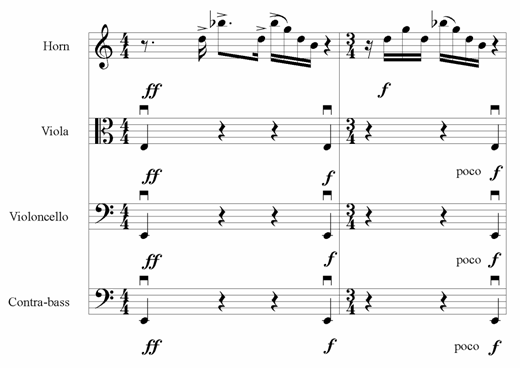
Example 5
An explosive force hits the listener from the very first beat of the Allegro. The horn, cellos, and basses interact using this motif to make up the A theme. In measure 56 the violas join this interaction to complete this first theme. The same material is presented again in measure 62, a half step lower. The violins join in with half the section playing arco and the other half playing pizzicato. This gives a strong percussive effect to the quarter note downbeats to reinforce the suggestion of struggle. This dialogue can be heard as a battle, going back and forth between the horn and strings.
A transition to the next thematic material begins in measure 67. The violins and violas play a slow melodic line in octaves while under this the cellos and basses play a triplet figure that gives movement to the phrase. Even when the melodic line becomes slower, there is an underlying nervousness, a sense of agitation in the music. This transition continues until the horn enters in measure 74 with the B theme (Example 6).

Example 6
A new sound is introduced in measure 80 with the horn and violas. The violas play divisi with the horn to simulate four horns playing together (Example 7).
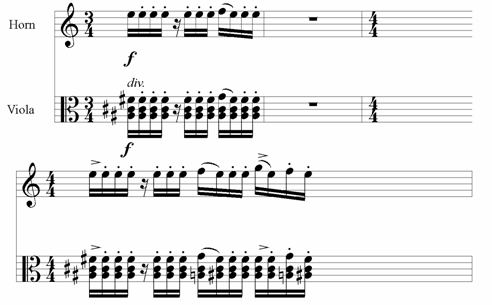
Example 7
This continues through measure 86 and is a preview of the rhythmic pulse that dominates the final Allegro. The transition in measures 87 through 89 is an ascending sixteenth-note scale traded off between the horn and the violins. A very subtle difference between the two parts occurs, creating an air of suspense: the horn plays an altered scale pattern with two whole-steps in the middle while the violins respond with the scale pattern introduced at the beginning of the piece. In measure 90 the horn sustains a concert D flat while the violins begin a descending scale that is continued through the lower strings. All the strings arrive on D flat in measure 92 and resolve to C with the horn. This half step tonal shift is used as a cadence to prepare for the recapitulation.
The A theme is played a major third lower than at the beginning of the Allegro but a minor third lower than the last time it was stated in measure 62. There continues to be throughout the piece the use of the minor third as a compositional point of reference. In measure 96 the first violins take over the second half of the A theme from the horn the second half of the A theme with the second violins completing it. As in the beginning of the Allegro, the diminutive statement of the A theme follows a half step lower with the same transition to the B theme. The horn and violas play the second statement of the B theme. Following this, a descending scale with crescendo to fortissimo is played in the strings, going from the upper to lower strings. There is a strong resolution using the half-step cadential motion to end the section.
The first Allegro is in the form shown below.
IA
IIA IB
Transition IIIA IVA IIB
(E)
(Eb)
(C)
(B)
Zwilich’s use of different tonal centers and voicings keeps the Allegro from becoming repetitive. At the same time she adheres to her idea of recurring motifs for the listener, as stated earlier. (See Chapter 2, Page 9).
The cadenza is written out but allows the performer to show their musicality. The score states, “Rubato is notated in the Cadenza, but it should be played even more freely and impulsively. Similarly, dynamics are indicated at structural points, but please feel free to add a great deal of color and dynamics.”6 Zwilich’s comments in the score indicate a certain freedom of interpretation.
Thematic material from the first two sections is incorporated into the Cadenza. It begins with the first motif from the Allegro, played a minor third lower. After this, the horn plays like two instruments or double stops on a string instrument. David Jolley influenced this particular effect. In his conversation with Ms. Zwilich, Jolley discussed how he did not like treating the horn like a horn and working on the Bach Cello Suites with Wendall Hoss.7 This cello effect can be heard with the use of the double stops, and later in the Cadenza with arpeggios (Example 8).
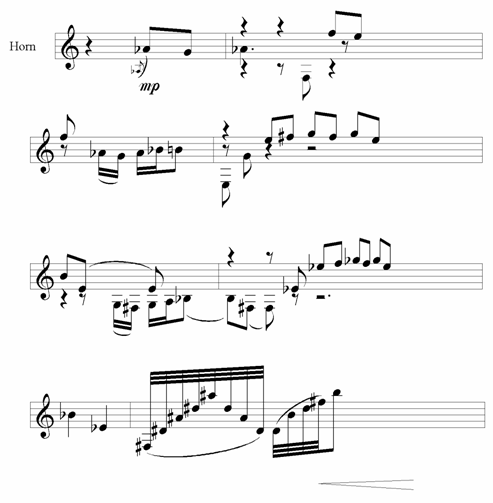
Example 8
Other effects used in the Cadenza, which are characteristic of the horn, are bending and stopping notes (Example 9).

Example 9
In measure 132, still in the Cadenza, the violas join the horn again to play as four horns. This passage is interjected with motivic material from the B theme of the Allegro. After this the horn goes from “expressive” to “bold and fortissimo” ending the Cadenza.
Jolley comments about the introspective nature of the Cadenza.8 This is clearly shown by the changes back and forth from slow melodic lines to pulsating sixteenth-note figures and arpeggios. The horn has the opportunity to show the entire range and dynamics of the instrument in a very free and expressive manner.
The cadenza is filled with contemplation on the part of the “Hero” of what has past and what is to come. There are struggles heard from within the music by the statement of previous thematic material. Ultimately, the music becomes more powerful as the heroic character seems to overcome the conflicts and finds renewed force to continue. To the author, this cadenza, musically, feels similar to the horn call in Wagner’s opera “Siegfried”, act II, scene 2. Here the horn represents the heroic character Siegfried and his inner struggles. After opening the call forcefully, the character becomes more reflective then continues on with force to triumph. All of this emotion is heard without text or orchestra, only the horn to represent this character.
Measure 140 is marked Tempo giusto, beginning the transition to the fourth section. The strings play a cluster chord with the second violins and violas playing divisi thirty-second notes and the first violins playing sixteenth-note sextuplets to create a pulse over an A pedal tone in the basses. The sounds of the cluster chords represent the confusion over the ever-present darkness in the pedal tones of the basses. The horn interjects with force to resume the battle, first with sixteenth-note sextuplets, then the next measure with thirty-second notes. On the last beat of measure 142 the horn plays an ascending arpeggio to a sustained and slow melodic line, based on the second motif in the introduction of the concerto (See Example 3, page 17), that continues through measure 148. During these measures a painful sound is heard from the horn as if crying for help, playing large interval jumps from the middle to the upper register of the instrument. All this is played over a pedal A in the basses and the cluster chords in the upper strings.
The horn and lower strings sustain E in measures 148 and 149. This gives the feeling of the dominant of A, as the next measure resolves to A major in first inversion. The progression is the same as the beginning of the piece, producing a half cadence. This is a tool used as a connector, anticipating the second half of the phrase. After an interjection by the horn in measure 151, the opening motif is played in the lower strings in the next measure. Over the next four measures a descending bass line, by half-steps, occurs to shift to a new tonal area. The horn plays a “free”, as stated in the score, obbligato line over this progression, perhaps the last cry for help before resignation. In measure 158 the violins enter on G sharp, taking over, enharmonically, the A flat from the horn. Tempo giusto is marked in the score to return to a steady tempo from the previous “free” section. The cellos and basses enter with the initial motif a minor third higher than at the beginning of the piece. The violas enter on the fourth beat of measure 161, filling out the triad. This chord is the same C sharp minor in first inversion as in measure 16 of the beginning of the piece. The horn enters to take over from the strings, playing the same upper neighbor motif from the beginning of the piece.
This recall is the beginning of a very long, slow melody by the horn. The violas join the horn in measure 168, playing in unison. In measure 172, the texture of the accompanying strings changes from sustained chords to pizzicato. The horn and violas continue to play over this quarter note pulse (Example 10).
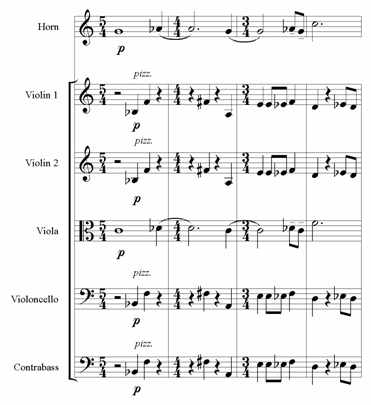
Example 10
The simplicity of the melodic development represents emptiness, almost as if it were a slow march to the gallows. This section ends with a recall of the first Allegro motif by the horn in measure 182, signaling an awakening of the senses to prepare for the final battle. The next three measures segue into the final section, the Allegro.
The general tonal area of this slow section is A. Pedal A is dominant throughout the cluster chords followed by A dominant seventh chord in second inversion. There are some transitional tonal areas in this section but the prominent tonal area is A. The use of A after beginning the concerto with D is a tonal reference to “classical” form. The second movement of a concerto is traditionally in the dominant key.
To begin the final section of the piece, a sixteenth-note pulse is established. This motor figure carries through to the end of the concerto. A strong quarter-note downbeat played by the cellos and basses announces the beginning of the final section. This is like the beginning of the first Allegro, signifying the struggle to overcome the darkness. In the next measure, the cellos play the motif introduced by the violas in the introduction, but it is now twice as fast (See Example 4, page 18). The horn enters in measure 188, playing repeated sixteenth notes. A driving, rhythmic intensity is created by this effect. This is rhythmically similar to the motif in the first movement with the violas representing four horns (See Example 7, page 20). The cellos begin the ascending scale pattern, whole-step, and half step, in measure 190. Joining enharmonically a minor third above, are the violas in the next measure. The second violins, followed by the first, enter with the same scale pattern. These four groups of instruments arrive on a tetrachord in measure 193. An alteration of this tetrachord takes place through measures 193 and 194 to arrive at a new tetrachord in measure 194 (Example 11).
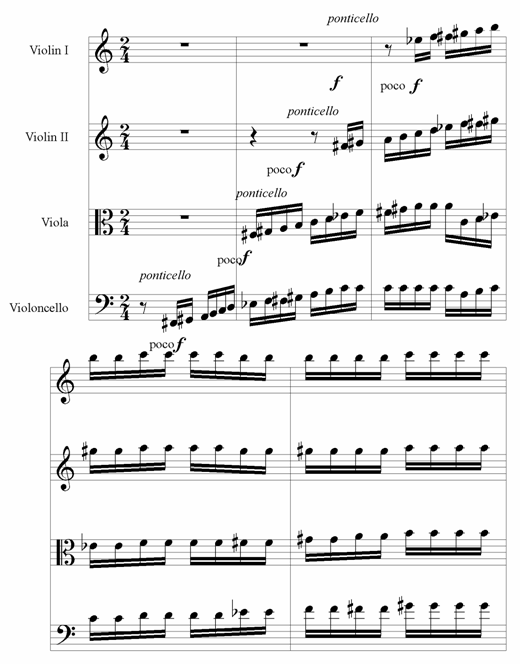
Example 11
All of these ascending scale patterns are an attempt to counteract the increasing strength of the horn. At the same time the sound of a new tetrachord is heard as a last attempt to change the course of the struggle in favor of the strings. The horn enters again in measure 195 with the repeated sixteenth notes. In measure 197 a diminutive and altered motif from measures 28 and 29 is played by the horn. This links the first and second halves of the theme (Example 12).

Example 12
The ascending scale pattern from measure 190 is played again under the sustained note of the horn. Once again the new tetrachord (See Example 11, page 28) is played while the horn continues playing a slow melodic line over the sixteenth-note pulse. To end this phrase, an octave jump is played by the horn, ending with the three-note motif from the beginning of the piece.
In measure 211 there is an abrupt shift to G sharp minor, restating the initial theme of this Allegro one step higher. Going one step higher, the horn is taken to the upper limit of its range. As before in the first Allegro, all strings play with the second statement of the theme. The violins play the repeated sixteenth notes in measure 215 that were first heard in the horn. After the ascending scales to the tetrachord, the horn enters in measure 222, playing the theme. The basses enter in measure 225, playing in octaves with the horn. Is this the beginning of conformity on the part of the strings or an attempt to take over the heroic character of the horn?
To end the phrase, the cellos and basses play octave jumps, as heard previously in the horn, and this begins the transition to the coda. In measure 235 and continuing to measure 238, the second violins and violas begin an ascending scale pattern a minor third apart. During this scale the first violins join the cellos and basses, alternately playing the octave jump. The whole transition to the coda uses three basic motifs, a scale, the three-note motif, and octave leaps. All of these are familiar thematic elements and represent a turn to closure of the piece.
The coda begins with the main three-note motif from the beginning of the piece, expanded and played by the violins over a divided lower strings sixteenth-note chord (Example 13).
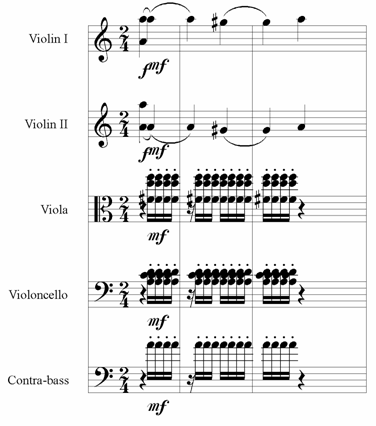
Example 13
The lower strings are playing in the upper register of the instrument, making one final reach in the coda to overtake the horn. This chord is not the same as before. It has qualities of a D minor seventh chord or a D dominant seventh chord in second inversion with a flatted tenth. This fluctuation between major and minor sound gives musical tension while the percussive pulse in the lower strings gives movement to the long, expanded line in the violins.
This continues until measure 253, where the basses begin an ascending arpeggio. The line continues to the cellos and then the horn (Example 14).
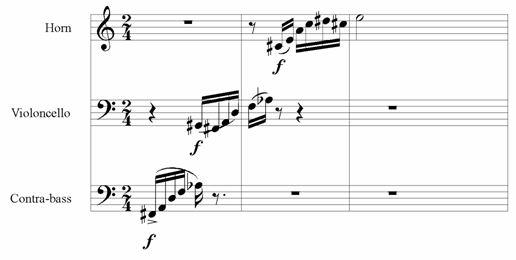
Example 14
The absence of the sixteenth-note pulse, as well as the addition of expanded melodic lines, abruptly slows the tempo in measure 255. Over long sustained lines in octaves in the violins, the horn recalls thematic material from the fourth section.
The lower strings start the pulse again in measure 267 with the motif from the beginning of the Allegro (See Example 5, page 19). In measure 275 the cellos and basses begin an ascending arpeggio, taken over by the horn in the next measure. The most interesting thing about this arpeggio is it begins with a perfect fourth. This is relevant to the dominant to tonic perception being set up (Example 15).
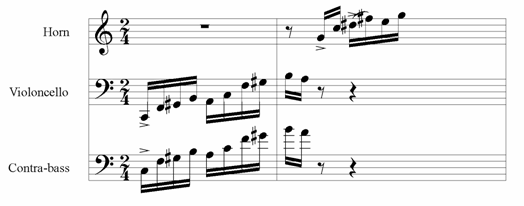
Example 15
Starting in measure 278 the horn begins a series of arpeggios trading off with the unison strings. Each arpeggio ends on a concert C in the horn and strings. For the first time, in measure 281, the horn plays a concert F major arpeggio. This is followed immediately by a sustained concert C, creating a dominant to tonic to dominant effect. There is a definite sound of conquest starting to be heard from the horn. The unison strings play the motif from the beginning of the final Allegro under the sustained note by the horn through measure 285. The cellos and basses continue with the same arpeggio from measure 275, followed by the violas and violins to complete the passage. The horn then plays the last ascending arpeggio, ending on concert C, in measure 288. This, in turn, resolves in the next measure to concert F that is sustained by the horn to the end of the piece. The strings play a final descending arpeggio in defeat. After the last descending tetrachord is heard in the unison strings in measure 291, they join the horn in measure 293 and sustain this unison F. The F is a minor third higher than D at the beginning of the concerto (Example 16). The question is, has the horn ultimately arrived as the victor or is there still darkness looming with the minor relationship of the final F to the beginning D?
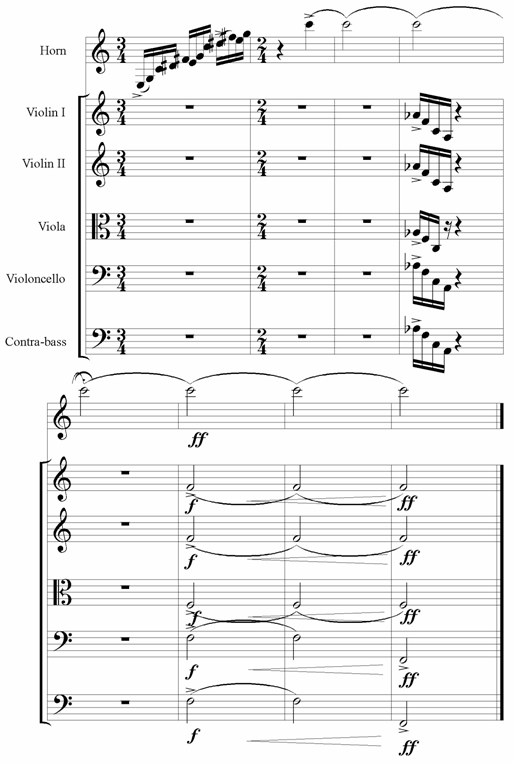
Example 16
There are three distinct tonal areas of the last Allegro as shown below.
IA
IB
Transition
Coda
(F#)
(G#)
(Transitional tonal areas) (F)
The minor third relationship is prominent throughout the concerto, even between the first and last notes of the piece.
Zwilich uses the string orchestra very effectively by combining different groups of the orchestra to emphasize motivic and tonal changes. Zwilich and Jolley conferred at the time of the commission and decided to use a string orchestra, one of the reasons being to afford more performance opportunities. Zwilich does not seem limited by the parameter of just strings. Rather, she is able to exploit the different colors of the string orchestra without covering the horn solo.
An analogy can be made comparing the string orchestra to a brass quintet. The violas take on the role of the horn by being able to play with both the upper and lower voices. Indeed, the violas and horn are frequently playing in unison in this concerto. The lower strings represent the darkness of the piece, playing below the pitch of the horn while the upper strings generally play above the pitch of the horn. An overwhelming sound of force is heard by combining the full string orchestra in the tutti sections of the piece. When the full orchestra accompanies the horn the sound becomes translucent in the softer passages enabling the horn to be heard effortlessly. At the same time, in loud passages the strings support the sound of the horn.
The horn is able to change the sound of the instrument through the use of the hand in the bell from covered to bright, depending on the extent the hand is closed or opened. In the louder passages a more open or bright sound is preferred to enable the soloist to project the sound with the minimum amount of effort. A softer or more closed sound can be used in the soft passages without fear of being covered by the strings. The range of this piece is almost three octaves, which demands a mature performer for this concerto. Zwilich’s orchestration allows the soloist to effortlessly bring out all the musical aspects of the concerto without sacrificing sound or technique.
To begin preparing this concerto, or any solo work, some knowledge of the accompaniment should exist on the part of the soloist. A general overview of the piano score will show the form and tonal areas of the piece. In studying the score, consideration should be given to the part the horn plays not only as soloist but in interaction with the accompaniment.
Zwilich is clear in her demands for the overall musical character to be achieved by the soloist. At the same time she states, “ I do like the idea that different performers with differing styles and character perform my work. I hope my works have enough depth to allow each solo performer to bring out different aspects.”1 David Jolley suggests “that performers try to let the different sides-the different ‘natures’-of the horn show as much as possible.” 2 The most evident resource for this is the dynamic indications. Zwilich has clearly written the different tempi and
playing range of the horn in an effective manner. The key to the work is scrupulous attention to the dynamics by both the soloist and the string orchestra.
The technical writing is well thought out, facilitating fingerings for the horn. The author prefers to play this concerto almost exclusively on the B-flat side of the double horn. This facilitates the technical passages by avoiding changing back and forth between the B-flat and F horn with the thumb valve. Also in the faster passages on the horn the notes in the middle to low register sound clearer when played on the B-flat side. This should not detract from the sound in this register but enable the performer to produce an even and clear sound throughout the horn’s entire range. With arpeggios covering over two octaves in the horn part, it is important to clearly hear all the notes, especially in the faster tempos.
To begin the work the dynamics of the initial 13 measures go from piano to forte. With the addition of different groups of instruments throughout these measures a natural crescendo will occur. Therefore, all instruments should make their entrances in piano dynamic and stay there. This allows the gradual filling of voices to make the crescendo. Only in the last two measures before 13 and the fermata, should an actual crescendo begin. An intense forte is created without overplaying the dynamic. The same intense forte should continue through the next two measures.
I have a personal preference in what follows with the entrance of the horn. In the piano reduction, measure 16 is a sustained chord by the piano and the entrance of the horn on the fourth beat is mezzo forte. At this slow tempo there is a very pronounced decay of sound by the piano before the entrance of the horn. Therefore, the horn should takeover the sound at whatever dynamic it might be. In the case of the string orchestra, the same should occur, the sound of the horn should evolve from the chord. The dynamic swell that follows is much more effective, again without overpowering the sound. Ultimately, the soloist is setting up the sound of the horn in measure 20, “Forte and brassy”.3
Special attention needs to be given to the opening measures of this work. Just as Zwilich clearly presents the motivic material, the performers must complete the presentation through the control of dynamics and color. The tone of the work, be it emotional or mechanical, is set very quickly in the beginning.
During the first part of the introduction the horn can use rubato bringing out the expressive line. However, starting in measure 31, the horn is interacting rhythmically with the orchestra and should remain in tempo. The unisons with the bass line in measures 39 and 45 can be clearer when played slightly marcato by all instruments involved.
The last chord of this section, measure 49, in the opinion of the author, should not be too long. A quick crescendo with the aid of the strings is very effective. There should be a very distinct break before going to the following Allegro. The buildup of musical anticipation to the Allegro is brought to a climax with this short silence before the first chord of the Allegro.
The Allegro beginning in measure 50 is clear and straightforward, with no
tempo changes. The dynamics are loud throughout the entire section. There are a few times when the dynamic is poco forte. This lesser dynamic should be heard as a change in character from the brassy and aggressive style to a full sound without an edge to the tone.
The soloist should be aware of the interaction with the orchestra. This is especially important in measure 80 and soforth when playing with the violas simulating four horns.
In the following Cadenza there are certainly several possible interpretations. Again, it should be stated, the most available tool is dynamics. Exaggeration of both the dynamics and tempos should be made. Pay attention not to rush to the next motivic statement using silence as a tool to anticipate the following phrase.
A personal change, at the beginning of the Cadenza I play hand stopped, not muted. This facilitates the immediate change to open horn in the fourth measure. There are straps to hang the mute from the wrist, as many players do. The mute hanging from the wrist will, however, deflect the sound of the horn and does quite often hit the bell of the horn. Dr. Zwilich had no objection to this change, she only wanted there to be a change in sound, either muted to open or stopped to open.4
Towards the end of the Cadenza the soloist sets the tempo for the reentry of the orchestra. The Grand Pause in measures 133 and 137 should be held a split second longer than the two beats indicated. This surprises the listener and sometimes the orchestra!
The horn continues the Cadenza in measure 139, once again in a liberal tempo. At the end of the Cadenza the last note of the horn should be held until the entrance of the orchestra in measure 140.
The following Tempo giusto should have a slight pulse even in the cluster chords. This can be done with the strings marking the beginning of each beat. There are a few points in this section where the horn can exercise rubato, such as at measures 151 and 155 to 157. After this the tempo should remain unchanged to the end of the slow section.
In measure 168 the horn and violas begin a long unison passage, in piano dynamic. A unique sound can be created with the correct balance between these instruments. The horn must blend with the violas and not attempt to play over their sound. Do not be afraid to really play piano. The sound will be heard, as the rest of the strings are playing pizzicato in piano.
At the end of the section the soloist can take time to play the recall from the first Allegro in measure 182. There is time to insert the mute because the orchestra stops playing. The segue to the following Allegro is very effective with the horn and upper strings sustaining the last note until the entrance of the lower strings on the downbeat of the next measure.
The final Allegro is like a motor. The only changes in tempo are caused by different note values. In measures 255 to 266 the sixteenth-note pulse is absent. The horn and violins must keep an inner pulse going for the reentrance of the sixteenth notes. Do not let the listener hear the pulse during these measures. The writing has created a suspension of time in the middle of the Allegro.
Dynamically, the strings have the responsibility to provide the major differences in this last section. The horn is basically forte throughout the Allegro with the exception of a few poco fortes. The strings, however, have some very distinct dynamic differences that need to be observed.
Four measures from the end there is a fermata with crescendo for the horn. A practical way to time the fermata with the crescendo might be to hold the note three beats before the entrance of the strings. Simply continue the tempo that has been established to end together.
More detail for performance has been given to the opening section of the concerto. The performer needs to have a good understanding of this material to use as a basis for performing the concerto. As the concerto progresses the recall of motivic material makes the interpretation easier to understand. Dr. Zwilich’s writing is very clear in both musical and technical aspects. The one most prominent factor in the different performance aspects is dynamics. Obviously, the different technical skills of different performers will come into play. However, the same performer can perform the same work differently at every concert. As a conductor once said to the author “have a little fantasy.”5
The performance of a major work, of which this is one, involves a certain amount of physical pain and perhaps mental anguish. Certainly this does not necessitate going into a deep depression. It does, however, involve reflection on the soloist’s part as to what they would like to present to the listener. Ultimately, it is the baring of one’s soul in the performance of a musical work that transforms notes on a page into a musical experience for both the musician and listener. This experience is a moment in time that is never heard before or duplicated afterwards, at least not exactly. Thus, is the anticipation and finally joy of experiencing live music.
The Concerto for Horn and String Orchestra by Ellen Taaffe Zwilich is a major work from the twentieth-century for horn. This work provides the opportunity for the soloist to show their technical ability on the instrument. It also affords the soloist the ultimate in musical reflection, as only a piece of this stature can. A successful performance of this piece by hornist and orchestra can be gratifying through the display of hard work in the practice room and inner reflection on the part of the musicians.
Barber, Suzanne K. “Orchestral Music by Ellen Taaffe Zwilich,” Notes: Quarterly Journal of the MLA (September 1989): 231-232.
Basingthwaighte, Sarah. “Guide to Performing Zwilich’s Concerto,” Flute Talk (February 1996): 14-15, 18, 28-29.
Ford, Andrew. “If I Could Say It With Words I Wouldn’t Write Music,” 24 Hours, The Publication of the Australian Broadcasting Corporation (June 1992).
Giffen,
Glenn. “Festival puts on a Jolley good show,” Denver
Post,
Grimes, Ev. “ Conversations with American Composers,” Music Educators Journal (February 1986): 61-64.
McDaniel,
Oestreich,
James R. “Orpheus Chamber Orchestra, Carnegie
Hall,” The New York Times,
Page,
Tim. “The Music of Ellen Taaffe Zwilich,” The
New Times Magazine,
Paikert,
Charles. “Composed Composer,” US,
Pincus,
Andrew L. “High Emotion from a Prize Symphony,” The
New York Times,
Sadie,
Julie A. and Rhian, Samuel, (Eds). The
Norton Grove Dictionary of Women Composers.
Schwarz, K. Robert. “Ellen Taaffe Zwilich,” BMI (1993).
_____.
“An Unconventional Composer Takes the Stage,”
Slonimsky,
Nicholas, (Ed). The Concise Baker’s Biographical
Dictionary of Musicians. 8th ed.
Smith, Tim. “Composer by the Sea,” Sun-Sentinel, April 1994: 1D, 4D.
Sturm, George (n.d.). “Encounters,” MadAmina! A Chronicle of Musical Catalogues.
“Good Grief! It’s…The ‘Peanuts Gallery’,” MadAmina! A Chronicle of Musical Catalogues, 1997.
Waleson, Heidi. “Composer Ellen Taaffe Zwilich, Living Her Dream,” Symphony Magazine, April/May 1986.
Walsh,
Michael. “A Bold, Brash Cello Symphony,” Time,
Zwilich,
Ellen Taaffe. Concerto for
Horn and String Orchestra.
_____. Ellen Taaffe Zwilich Concerto for Horn and String Orchestra, Program note by the composer, 1994.
Terry Roberts, (b.
[1]
Glenn Giffen, “Festival puts on
Jolley good show,” Denver Post,
[2] Ibid.
[3]
Sharon McDaniel, “Polished
performance marks new brass concerto’s
4
James
R. Oestreich, “Orpheus Chamber Orchestra, Carnegie
Hall,” The New York Times,
5 David Jolley, New York, to Terry Roberts, Florence, South Carolina, 10 March 1999, transcript in the hand of Terry Roberts, Florence, South Carolina.
6 Ellen Taaffe Zwilich, Pompano Beach, to Terry Roberts, Florence, South Carolina, 4 February 1999, transcript in hand of Terry Roberts, Florence, South Carolina.
1
Tim
Page, “The Music of Ellen Taaffe Zwilich,” The
New York Times Magazine,
2 Ibid.
3 Tim Smith,
“Composer by the
Sea,” Sun-Sentinel,
4 Andrew Ford, “If I Could Say it With Words I Wouldn’t Write Music,” 24 Hours, The Publication of the Australian Broadcasting Corporation Vol./Issue (June 1992).
5
Tim
Page, “The Music of Ellen Taaffe Zwilich,” The
New York Times Magazine,
6 Suzanne Kimberly Barber, “Orchestral Music by Ellen Taaffe Zwilich,” Notes: Quarterly Journal of the MLA (September 1989).
7
K.
Robert Schwarz, “An Unconventional Composer Takes the
Stage,” The New York Times, reprinted in
the Tallahassee Democrat,
8 Ibid
9
Charles Paikert, “Composed Composer,” US,
10 K. Robert Schwarz, “Ellen Taaffe Zwilich,” BMI (1993).
11 Ibid.
12
Ellen
Taaffe Zwilich interviewed by author
1 Ellen Taaffe Zwilich, Pompano Beach, Florida, to Terry Roberts, Florence, South Carolina, 4 February 1999, Transcript in the hand of Terry Roberts, Florence, South Carolina.
2 Ibid.
3 David Jolley, New York, to Terry Roberts, Florence, South Carolina, 10 March 1999, transcript in the hand of Terry Roberts, Florence, South Carolina.
[4] Ellen Taaffe Zwilich, Pompano Beach, Florida, to Terry Roberts, Florence, South Carolina, 4 February 1999, transcript in hand of Terry Roberts, Florence, South Carolina.
[5]
Ellen Taaffe Zwilich, Concerto for
Horn and String Orchestra, Program notes by the composer,
6
Ellen
Taaffe Zwilich, Concerto for Horn and String Orchestra, Theodor
Presser,
Inc.,
7 David Jolley, New York, to Terry Roberts, Florence, South Carolina, 10 March 1999, transcript in the hand of Terry Roberts, Florence, South Carolina.
8 Ibid.
1 Ellen Taaffe Zwilich, Pompano Beach, Florida, to Terry Roberts, Florence, South Carolina, 4 February 1999, transcript in hand of Terry Roberts, Florence, South Carolina.
2 David Jolley, New York, to Terry Roberts, Florence, South Carolina, 10 March 1999, Transcript in the hand of Terry Roberts, Florence, South Carolina.
3 Ellen Taaffe Zwilich, Concerto for Horn and String Orchestra, Bryn Mawr, Pennsylvania, Merion Music, Inc., 1993.
4
Interview with Ellen Taaffe Zwilich by author
5
Sandor Vegh, in rehearsal with the author,